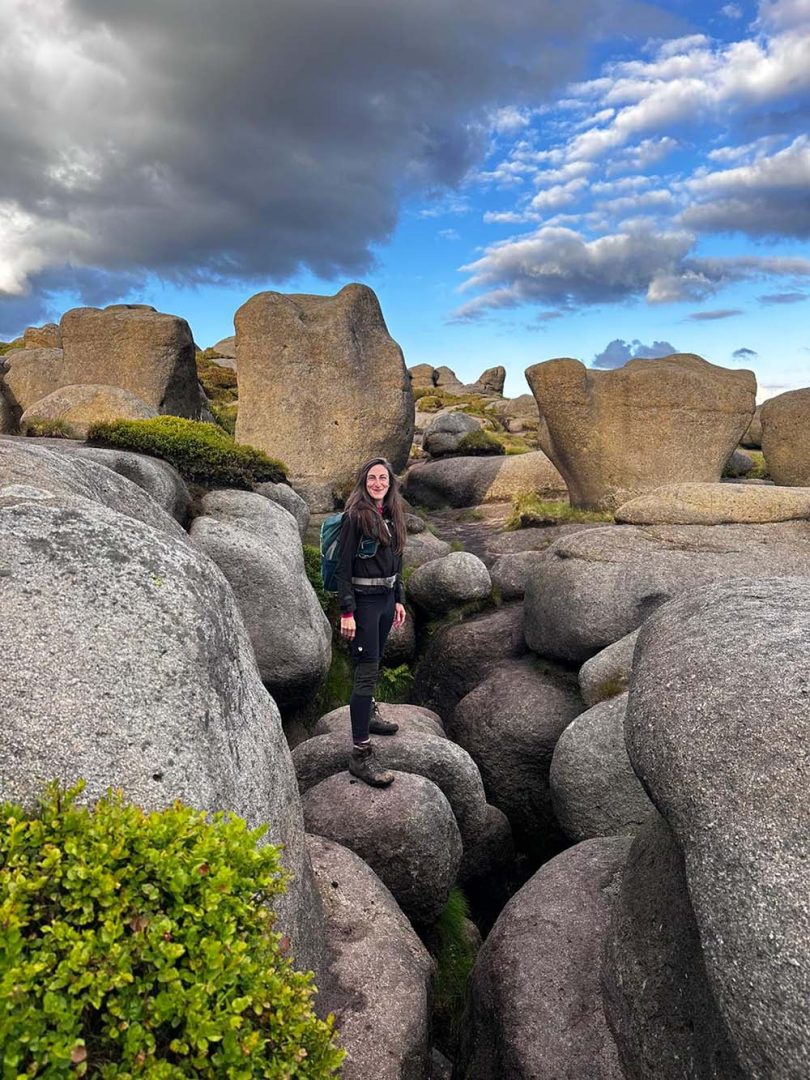Britain’s best hidden beaches, ruins, waterfalls, forests and adventures.
Daniel Start, author of the award-winning Wild Guide guidebook series, reveals his favourite all-time hidden and wild spots to visit across Britain. Here are some ideas for the perfect adventure, pitstops included!
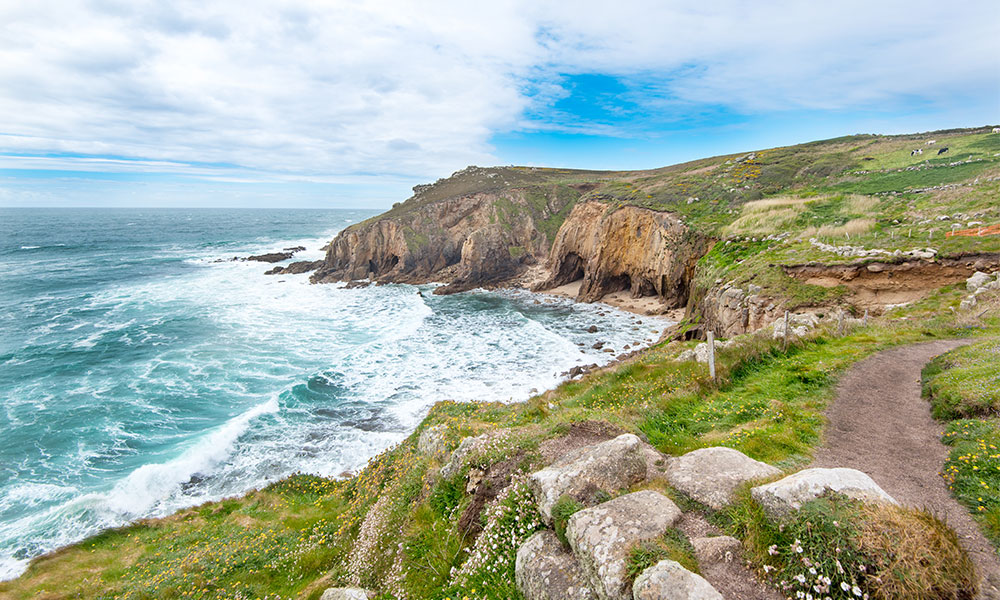
Path near Nanjizal Bay
West Cornwall beaches, sea caves and quoits
For the wildest and most beautiful sands in England, seek out the atoll-island sand bars at Pedn Vounder, just east of Porth Curno, a spectacular bay with shallow lagoons. It’s a remote and wonderful place to while away the heat of the day paddling in turquoise waters.
Continue on for another mile or so to find several more secret beaches. Porth Chapel with fun ledges to jump from, Porthgwarra with a secret tunnel and finally the real edge Land’s End, at Nanjizal Bay Here, at low tide, you can swim through the “song of the sea” rock arch, wallow in jade-green plunge pools and snorkel into sea caves gleaming with coralline. There’s also a rope by which you can descend to giant caverns and a secret beach on the far side of the bay.
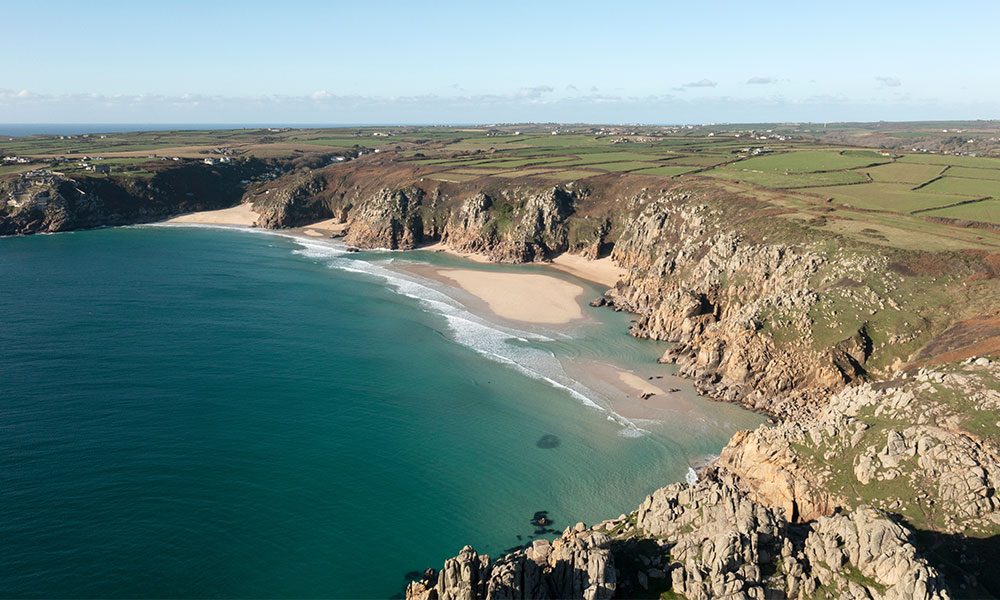
Pedn Vounder
As the afternoon draws on, take in some of the mystical bronze-age sites that adorn the landscape. Dance barefoot around the little-known Boscawen-Un stone circle, four miles north-east beyond St Buryan, explore the underground “fogou” burial chambers at Carn Euny, a mile further on near Sancreed, or head eight miles to the north coast and climb high onto the golden moor to the stone shelter at Zennor Quoits. Here, on a wild craggy outcrop, nearly 350m above the sea, there are stupendous views out over the western ocean.
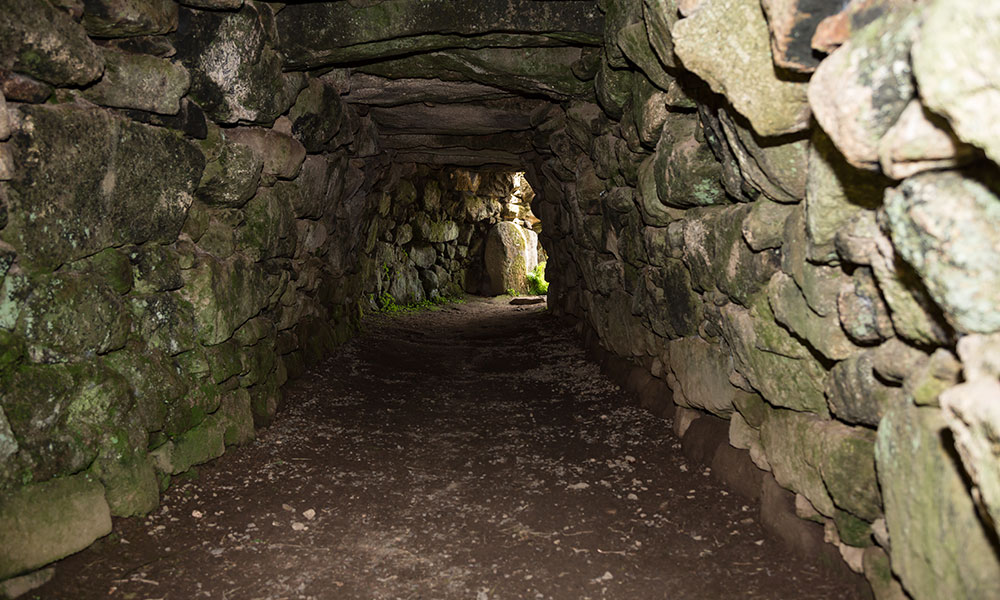
Carn Euny
Sleep beside the Quoit itself, or snuggle down in among the heather as night jars sing and stars fill the indigo sky.
Pitstops: Above Pedn Vounder beach at Treen there’s a clifftop campsite and a tiny cafe serving breakfast porridge with clotted cream, bilberry jam and heather honey.
Dartmoor ancient woods and stone rows
Dreaming of ancient stones and moorland waterfalls? The Erme is the hidden jewel of Dartmoor. Begin at the sandy river estuary of Mothecombe, the mouth of the tiny river Erme. You can canoe, paddle or swim upstream through the peaceful creeks and silent backwaters, inaccessible except by water. There will be kingfishers, curlew and oystercatchers and, if you bring a line, you might catch sea bass.
Follow it up to Ivybridge to find dramatic waterfall pools, then trek into the moors a miles to find the gnarled, twisted oak woods of Piles Copse, the most ancient fragment of Dartmoor’s once verdant forests – like something from the Hobbit.
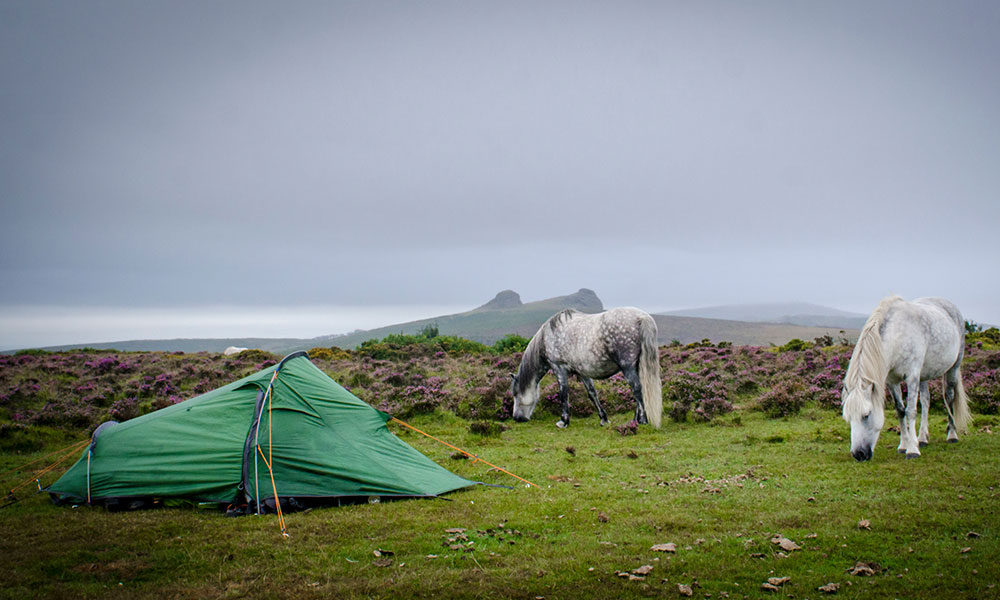
Dartmoor Wild Camping
Continue up the Erme and, as views open out to the sea behind you, Dancer’s Stone Circle appears and the giant standing stones of Staldon Row appear and beckon you on to Upper Erme Row. Stretching more than two miles, this is the longest stone row in Britain – possibly the world – yet little is known of its origins or purpose.
For a real haunting feeling, embark on a night walk. My favourite is the Lych Way which is a corpse road from Postbridge to Lydford – along which the dead were taken for burial. Set out on the walk by the milky light of a full moon. You will see the cart tracks of the coffin bearers, which are still visible, worn into the stone road. Reach Coffin Wood near Willsworthy in the early hours, and fall into a deep, haunted sleep under the gentle sway of the ancient beech trees.
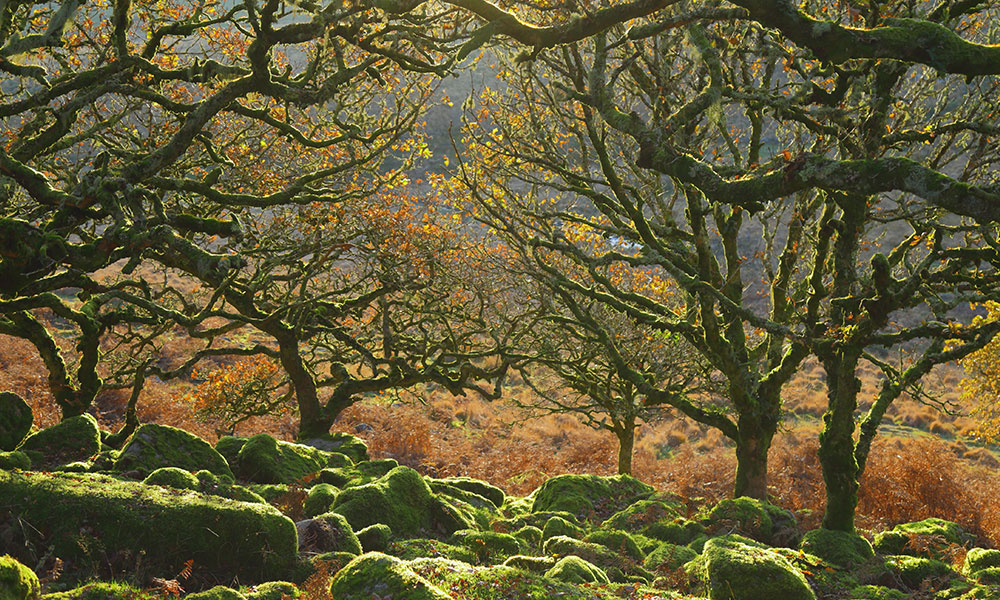
Dartmoor woodland
Pitstops: Wild camping is encouraged on Dartmoor. Piles Copse is an idyllic place to wild camp, with a pretty stream setting, or continue further up the Erme valley, or up to Leftlake Mires. Peter Tavy Inn, originally built as lodgings for the stonemasons while they rebuilt the village church of St Peter, in the 14th or 15th century. Lovely, secluded pub in a quiet moorside village with good food.
Sussex Downs yew groves, follies and canoes
The Sussex downs are steeped in history and legend, with dramatic hillforts and ancient trees. Kingley Vale is one of the finest yew woods in Europe and includes several groves of ancient, twisted trees which pre date Christianity and are thought to be the oldest living things in Britain.
Bronze Age remains are nearby too – a few miles north yields first the Devil’s Humps and then the Devil’s Jumps – huge burial mounds for Celtic kings. Beacon Hill, a short walk further along the ridge path, is an old hillfort with some of the best views in Sussex. It’s a wonderful place to bivy out and watch for glow worms and shooting stars.

Kingley Vale
Another place to spook yourself are the fantastical ruins of Racton Folly, an abandoned mid 18th-century tower, lost in the woods. It was inspired by the Radcliffe Observatory in Oxford and has sweeping views down to sheltered salt lagoons of Chichester Harbour.
A great place for swimming and canoeing among myriad creeks and coves in the harbour is pretty Prinstead Cove, conveniently situated off the main A27, with warm waters heated by the mud flats at high tide. Or for a real adventure embark on the hour’s walk or canoe to the desert island and nature reserve of Pilsey, only accessible at low tide, a place completely cut off from the modern world.
Pitstops: Retreat to the feral comforts of the haunted Royal Oak, hidden up a track deep in the woods behind. They serve up frighteningly strong ‘Exmoor Beast’ under oak beams. For more traditional camping, try remote New House Farm, high on the downs in a huge clearing surrounded by impenetrable forest. This is about as wild as proper campsites get. New House Farm camping, East Dean, Chichester, PO18 0NJ, 01243 811685.
West Pembrokeshire blue lagoons, sea arches and ruins
The breath-taking coastline of Pembrokeshire is at its quietest and wildest at its western extremities. Tapestries of spring and summer wild flowers are set against the sparkling backdrop of the turquoise sea. There are some extraordinary beaches but my favourite is the stretch between Abereiddy and Porthgain. The Blue Lagoon never fails to amaze, an old quarry, now an oasis which empties and fills with the tides, it’s a wonderful place to wild swim. There are also thrilling jumps into the jade waters from the remains of the old engine house, with multiple levels as you build up your confidence.

Blue Lagoon
Continue along the coastline a mile to one of Britain’s best beaches, Traeth Llyfn, it’s a great place to skinny dip as it’s often empty.. Another mile to the east brings you to Penclegyr, an exciting headland with an with arch and chasm. Descend on ledges and you can swim around it through narrow corridor channel. Above is an abandoned cliff top quarry, with hoppers and old tramways that lead down into the diminutive harbour village of Porthgain over-looked by abandoned Victorian brickworks.
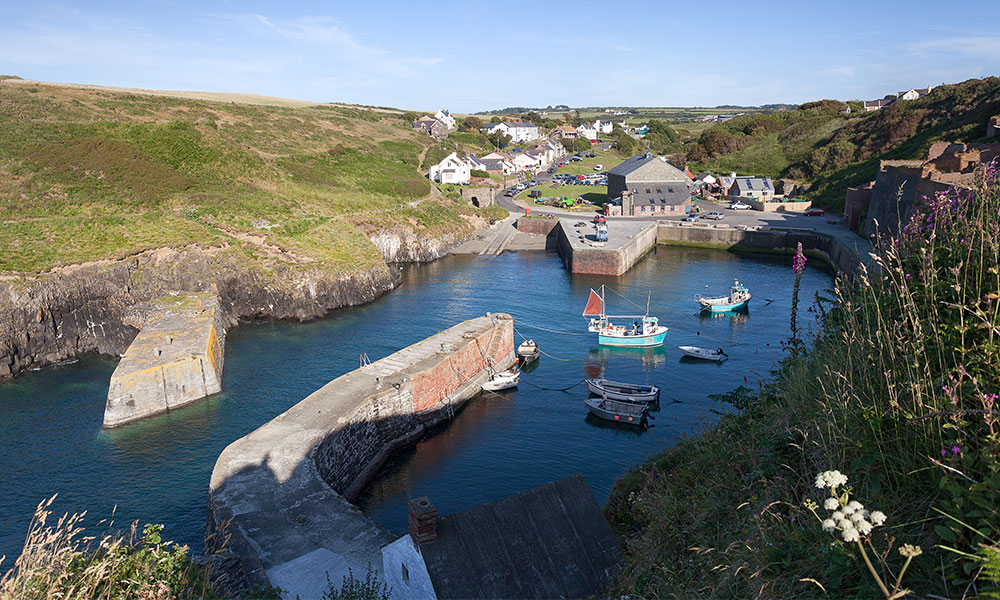
Porthgain
Pitstops: One of the best places to enjoy fresh fish or crab is at ‘The Shed’, right by the waterside. For the night, Trellyn woodland camping is a lovely quiet site in a wooded valley, sheltered from the sea winds and yet right on the coast path. It offers simple camping facilities, an outdoor bread oven with stargazing and campfires de rigeur. Book the meadow field, or sleep in their teepee.
North Yorkshire Dales slot canyons, waterfalls and lost castles
Ruined castles line the wild valley of the Eden as you wind your way ever higher through remote fells to Garsdale Head. First is the crumbling remains of Lammerside Castle set in meadows beneath rocky outcrops, complete with vaulted crypts and cellars to explore and then the wonderfully named Pendragon Castle besides a river. This castle was built as a fortified tower-house in the 12th century and legend says that Uther Pendragon, father of King Arthur, died here. Downstream along the river is wonderful hidden pool for wild swimming.
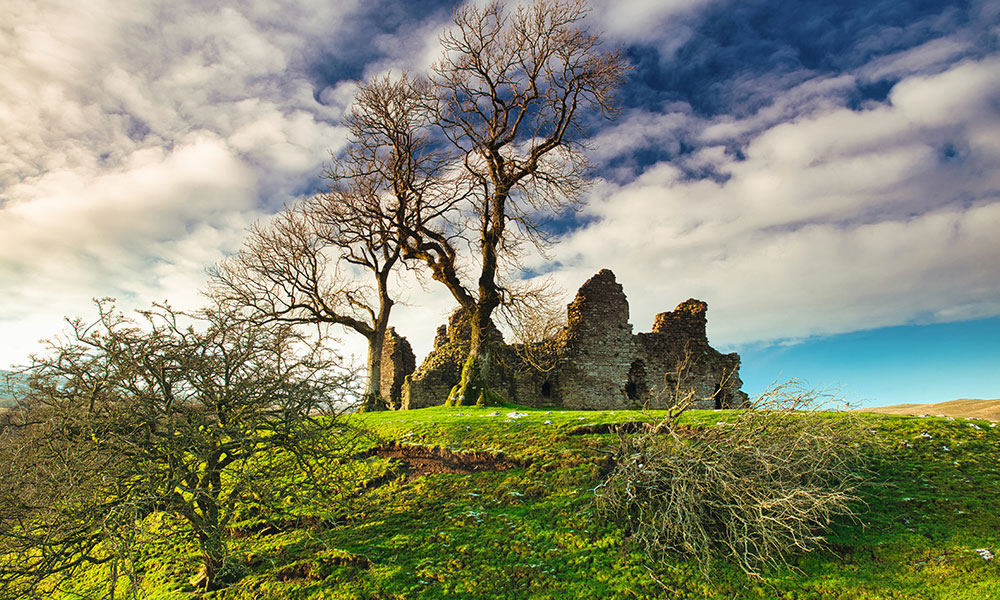
Pendragon Castle
The more adventurous explorers should continue another four miles to Hell Gill farm. There is a patch of woodland on the fells above which hides a remarkable limestone slot canyon, ribbed and carved by the passage of water. As you descend fearfully it becomes darker, wetter and narrower, like entering the bowels in Jonah and the Whale. At the mid-point there is a leap into a large plunge pool, and then it is fairly easy going to the end. Do not enter if rain is expected. For a simpler swim try Cotter Force waterfall a little further on, with a deep pool and flat rock slabs.
Pistops: This is an isolated place to be as night falls, but you can still be assured a warm welcome at The Moorcock Inn, which stands alone on the pass, one of the most remote pubs in Britain. There are rooms here too, and the drinks and tales flow long into the early hours.
Isle of Lewis coral beaches, orchids and ancient man
The Isle of Lewis is only two hours from the mainland, but its coral white beaches, rare orchid grasslands and pre-Christian remains make it feel much further. This was one of the first places man settled in Britain and the standing stones of Calanais, almost 5,000 years old, and are thoughts to an ancient astronomical observatory. Nearby are the ruins of strange igloo-shaped stone ‘brochs’ (fortified homesteads). Dun Carloway, is ‘only’ 2,000 years old, but still has staircases to climb and stunning views. On the beautiful beach at Bostadh you can even go into and explore some of the Iron Age round houses.

Isle of Lewis
The wild Hebridean beaches are perhaps the greatest draw though. Visit in July for the height of the coastal ‘machair’ – thick carpets of orchids, harebells, meadowsweet, and clover that stretch out behind crystal-clear aquamarine seas. The white sands are made from the fragments of shells brought in from faraway places on the drifts of the gulf stream. Our favourite secret beach is Carnais on Uig Bay, a perfect cove of white sand. On the little road to there stop at the wonderful roadside waterfalls that lead from Loch Stacsabhat down to the bay – the pool here is deep, peaty and pure.
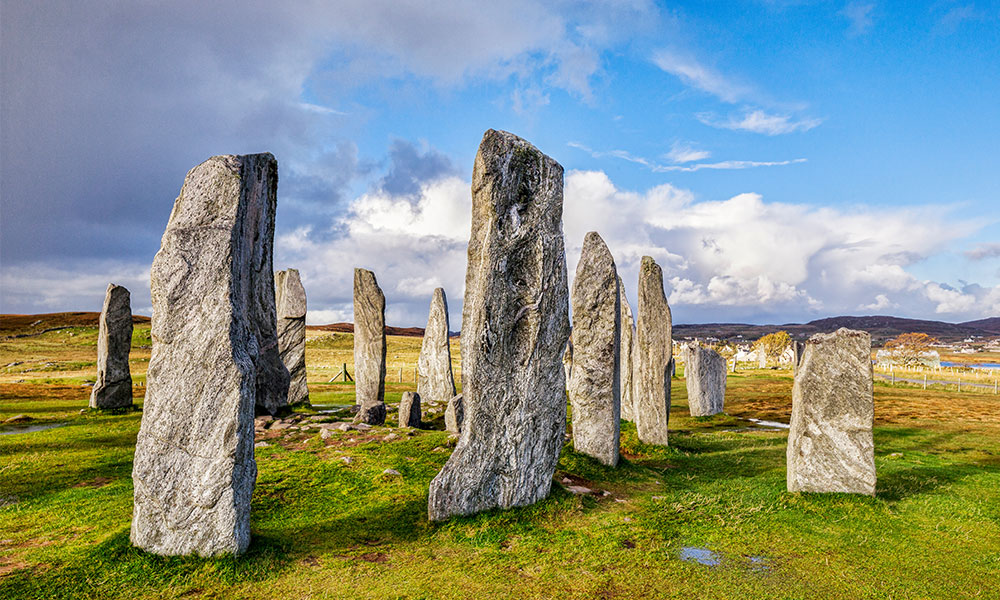
Standing stones of Calanais
But also explore the beaches north of Uig Bay – Cnip (Kneep), Bhaltos (Valtos) and Traigh na Beirigh (Reef Beach), where you will find simple community-run campsites or why not wild camp on the beach. Scottish access laws allow this if you are far enough from another house and leave no trace. There’s no better way to wake up in the morning than a dip in a crystal blue, freezing ocean.
Pitstops: Wild camping is allowed in Scotland. For a spot of complete wild luxury try Auberge Carnish, a mini hotel and restaurant with views overlooking vast sweeps of incredible white shell sand.
Add these hidden gems to your bucket list and discover what Great Britain has to offer. These destinations are perfect for a weekend away or a longer staycation. Find walking, cycling and more routes around these hidden locations in OS Maps.



